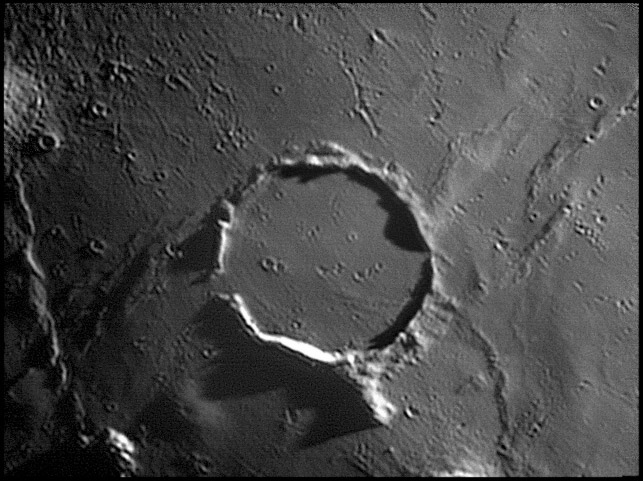February 7, 2018
A Hole in the Wall
Originally published August 23, 2008

image by Damian Peach
South of Bullialdus in western Mare Nubium is a crater remnant that is always a treat to observe, perhaps because it seems that we just caught it before it completely disappears. Kies is the upper rim of a crater whose insides were buried by mare lavas. Did they enter through the gap in the western wall, or is that hole coincidental and the lavas welled up from below the crater as in Plato and Archimedes? Originally Kies probably looked similar to Bullialdus, with a mountain in the middle of a small flat floor, surrounded by terraced and slumped walls. A fresh crater 44 km wide, as is Kies, was probably about 3 km deep, but now its highest rim segment rises only about 400 m above the lava floor, so the lavas inside are about 2.6 km deep. I wonder if the high spot on the eastern rim is related to the mare ridge that abuts it? If ridges are thrust faults that slide one piece of lava above its neighbor, perhaps that piece of Kies' rim was lifted up by the faulting; it is surprising that the ridge/fault does not appear on the crater floor. The lavas in and around Kies are punctured by numerous little secondary craters, from Konig - just northwest, Bullialdus, and more distant Tycho (also forming the bright streak seen with higher lighting). And the final delight here is the classic, pit-topped dome Kies Pi, just touched by a Kies rim shadow. This volcanic hill is about 14 km wide at its base but only 160 m high, giving an average slope of just 1.4°. This is a great place to start your lunar dome collection!
Chuck Wood
Technical Details
2006/04/08. C14 @ F41. LU075M.
Related Links
Rükl plate 53
Yesterday's LPOD: Cleomedes Unveiled
Tomorrow's LPOD: Who Says You Can't Have It All?
COMMENTS?
Register, Log in, and join in the comments.



